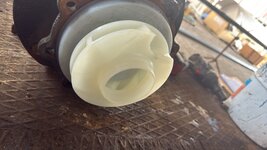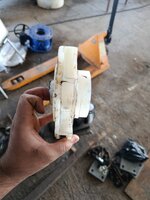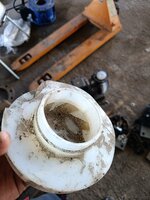Although a sealless positive displacement pump guy, I have seen my share of damaged impellers; definitely need to double check your temperature to ensure you do not have an upset condition and in such an upset condition you might also have insufficient NPSHa, so you end-up with both temperature and cavitation stress on the impeller. Also, is it possible that there are any solids getting into the pump? It is very difficult to thoroughly trouble-shoot a pump application in a forum, here's how I try to guide the conversation: 1st, did the application ever work correctly - without such damage? If so, what has changed since then? If this has been an issue from day 1, it is likely not a pump problem as much as an inlet condition issue. Transient upset conditions such as a clogged inlet filter, miscalculation of NPSHa, temperature upsets etc... the material is reacting physically and perhaps chemically to your application. Hopefully your vendor will take the time to walk through your system and provide ideas to aid with identifying the root cause of damage. It might be that a centrifugal pump is not the best type for your application.
 Hi everyone, we are using this pump to transfer sulphuric acid. Our concentration is %85 and this impeller MOC is PVDF. This impeller got some damage but we don’t know the reason. There is no particule on fluid it is clean and closed system. I have faced this problem 3 times and I want to know reason to solve problem. I have calculated the NPSHa and it is almost 6m, NPSHr is 3m hence there is no cavitation. What can be the reason could u help me?
Hi everyone, we are using this pump to transfer sulphuric acid. Our concentration is %85 and this impeller MOC is PVDF. This impeller got some damage but we don’t know the reason. There is no particule on fluid it is clean and closed system. I have faced this problem 3 times and I want to know reason to solve problem. I have calculated the NPSHa and it is almost 6m, NPSHr is 3m hence there is no cavitation. What can be the reason could u help me?

